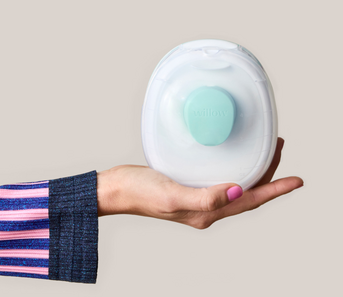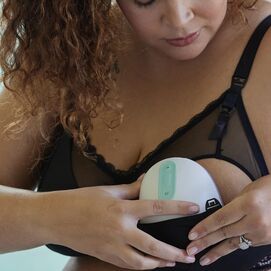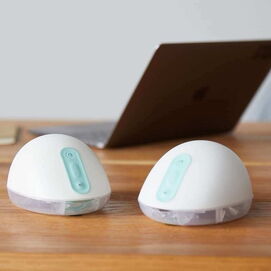Trying to perfect your breastfeeding latching technique? We know it can be tough, especially if this is your first time breastfeeding. First, take a deep breath and pat yourself on the back, mom. You’re doing great so far!
Next, read this guide. Here, you’ll find all the insight, tips and tricks you need to perfect your latching technique, including breastfeeding positions, a step-by-step guide on finding a deep latch and more.
What Is "Latch" and Why Is It Important?
A baby’s “latch” simply means how your baby attaches to your breast when it comes time to eat. For a baby to get the most milk from your breast, they should have a strong and deep latch. A good latch helps your baby eat comfortably, reducing the stress and frustration of breastfeeding for baby and mama.
There are many things involved when it comes to latch. Everything from your breastfeeding position to just how hungry your baby is will affect your baby’s latch. For the best results, you must consider each factor, one by one. Let’s jump right in.
Watch for Your Baby’s Hunger Cues
Sometimes, successful breastfeeding means allowing your baby to lead. So, you’ll want to keep an eye out for your baby’s hunger cues. According to the USDA’s WIC Breastfeeding Support, there are several cues your baby may give when it’s time for a meal:
- Fists moving to their mouth
- Head turning to look for your breast
- Becoming more active or alert
- Sucking on their hands or lip smacking
- Opening and closing their mouth
Other hunger cues may include restlessness or your baby may stick their tongue out. The USDA states that waiting for your baby to cry might be too long. Most babies will signal their hunger before they begin to cry. And a crying baby may have difficulties latching. So, keep an eye out for any signs of hunger first.
Latching Technique 101: How to Find a Deep Latch
Once you determine that your baby is hungry, it’s time to try and get a deep latch. Here are a few simple steps to follow first:
-
Run your finger over your baby’s lips so they open their mouth wide. This is super important for latch.
-
Next, aim your nipple at your baby’s top lip.
-
Then, aim your baby’s mouth past the bottom of your nipple. The first sign of a good latch is that your breast fills your baby’s mouth.
The key here is to look out for pain or discomfort. Your baby’s latch shouldn’t be at all painful. If it is, stop your baby’s latch and try it again.
What Does a Good Latch Look Like?
There are many signs when it comes to a good latch. For example, your baby’s lips will turn out instead of being tucked in. You’ll also be able to hear your baby or see them swallowing as they eat. Your baby’s chin will touch your breast due to how wide their mouth is opened and your baby’s mouth will encompass your whole breast, not just the nipple.
What Does a Shallow Latch Feel Like?
A good latch will simply feel like your baby is pulling or tugging. If your baby’s latch is shallow, you may feel pain or discomfort. For example, you may feel a pinching sensation on or around your nipple. If a breastfeeding session is uncomfortable, break the latch and start over.
Choose an Effective Breastfeeding Position
A good latching technique will also depend on the breastfeeding position you choose. You’ll want to pick a position that’s comfortable for both you and your baby. After all, you may be in this position for a while during each breastfeeding session.
According to Sanford Health, there are a few different key positions you can try to see what works best for you and baby:
-
Cradle: Place your baby in the elbow area of your arm on the same side as the breast you’re feeding on. Your baby should lie horizontally to your body, belly to belly. You can then use your other hand to support your breast as your baby feeds. This hold is also easy lying down. Simply place your arm under your baby's head and lay side by side.
-
Cross-cradle: Place the opposite hand from the feeding breast on your baby’s head for support while sitting. Then, just like the cradle hold, your baby’s body will lie horizontally to your body, belly to belly.
-
Football: Sit up and hold your baby at your side. Your baby will lie close to the outside of your body with their mouth positioned up to your feeding breast. Then, support your baby’s head with your hand and their body with a pillow.
When to Stop
Sometimes, latch can be difficult to obtain. This can be frustrating for both you and your baby. If you feel like you’ve tried everything with no luck, please reach out to your doctor, pediatrician or OB/GYN. They may be able to give you some advice on what you can try next.
Choosing to breastfeed your baby is your choice and it’s something only you can decide for yourself and your baby. If you feel the need to stop or are advised by your healthcare provider to stop, there’s no guilt in doing so, mama.
There are other options available. For example, you could try pumping your breast milk and then feeding your baby via bottle. This way, your baby still gets all of the benefits of your liquid gold but without the tears and stress.
Common Latching Problems: Your FAQs Answered
Guess what—latching problems are super common. In fact, according to the CDC, issues with latching are included in the top reasons why babies stop breastfeeding early. Common issues include difficulties with baby opening wide enough for proper latch, clamping down, pushing away and more.
How Do I Get My Baby to Open Wider to Latch?
First, start with one of the positions listed above so your baby has easy access to your breast. You’ll also want to make sure you’re holding your breast beyond the nipple and areola so your baby has plenty of room.
Try placing your finger lengthwise beneath your baby’s bottom lip and gently pull down to encourage your baby to open wide. And don’t forget to tickle your baby’s lips which can also help.
How Do I Keep My Baby From Clamping Down When Breastfeeding?
Clamping or even biting can be seriously painful for breastfeeding moms. Some babies may clamp down due to excess milk flow or even too little milk flow.
The key here is to pay attention to the moments where your baby is clamping or biting. Are there signs to show why? For example, is your baby in an uncomfortable position? Is your flow slowing in those moments? If you can pinpoint what’s making your baby react, you can take the steps to switch things up.
For example, if too little flow is the issue, try breast compressions to increase your flow. Or, switch your breastfeeding positions. Some moms with older babies find that stopping the feed after a bite can help your baby learn that biting isn’t okay.
Why Does My Baby Not Latch Sometimes?
There are many reasons why a baby might not latch at times:
-
Your baby is overly hungry and irritable which may result in latching difficulty
-
Your breasts are engorged which makes it difficult for your baby to latch onto your breast
-
Your baby is in an uncomfortable breastfeeding position
-
Your baby is experiencing nipple confusion if they’re bottle-fed and breastfed
-
Your baby is going through a nursing strike which is when your baby refuses to nurse
Most of these issues can be resolved simply over time. For example, if your breasts are engorged, you could try expressing milk by hand or pumping. And if your baby is in an uncomfortable position, you could simply switch it up.
As for nipple confusion, consistency is key. Keep trying to give your baby your breast. It might be helpful to express a bit of milk before latch to try and inspire your baby to suck. Or, you can try a nipple shield to simulate the feel of a bottle.
Why Do Babies Push Away When Latching?
If your baby is pushing away when latching, your milk flow may be too fast, especially at letdown. If this is the case, try removing your baby from your breast for a few moments. Then, try again. You may also need to nurse more often to even out your supply which can help with forceful letdown.
Be Patient
Chances are, you and your baby won’t get the hang of breastfeeding overnight. Although babies are born with an ability to breastfeed, it can take some time and practice to get the latch just right. You must be patient.
If you’re struggling, there are plenty of resources available to you. Talk to your doctor or your baby’s pediatrician for support. Or, you can also contact your local La Leche League for help and guidance.
Breastfeeding? We’re Here for You, Mama!
Breastfeeding is a journey with plenty of bumps in the road. But, we’re here to support you! Check out our blog for more breastfeeding and pumping tips and tricks.
Get pumping support with Simplifed
Get pumping support with Simplifed
Get access to free virtual feeding support from the lactation consultants at Simplifed. They can help you navigate supply issues, introduce a bottle, and more, and are trained on Willow pumps.














